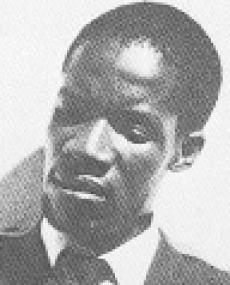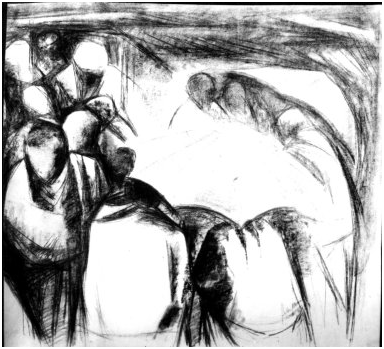
Selbourne Charlton Sobizwa Mvusi (known as Selby) was born in Richmond, Natal (now KwaZulu-Natal) on 18 June 1929, to Vunina (born Nxasana) and Jotham Mvusi, second generation Christian converts and prosperous farmers. Selby’s father was a graduate of the prestigious Fort Hare University and graduated in 1935 with a Theological degree. His grandfather was a Methodist priest and a wealthy land owner who lived in Ixopo, Natal.
The Mvusi family moved to Alice, Eastern Cape when his father was appointed Secretary General of the Students Christian Movement at the University of Fort hare. Selby and his older sister attended the Lovedale Presbyterian Church Primary School. When Selby’s father moved back to Durban to take up the post of senior minister of the Methodist Church in Durban, Selby was sent to complete his primary schooling in Ndaleni in the Natal midlands. He then attended the prestigious Adams College near Amanzimtoti, Natal, where he completed his high school education in 1948.
In 1949 Selby enrolled for a Bachelor of Arts Degree at Fort Hare, which was the only university opened to Black, Indian and Coloured South Africans as well as students from other English speaking African colonial-administered countries.
At Fort Hare Selby found himself part of the growing, influential radical nationalist African National Congress Youth League (ANCYL) and other student political groups. He was actively involved in student organisations and was elected to the Students Representative Council. Fort Hare did not have a fine art facility, however, he attended a short course on graphic art run by his English Professor Donald Stuart, who was an accomplished artist.. Stuart took Selby and a few of his other students on regular weekend sketching tours in and around Alice and the Hogsback. In a letter to Selby the artist Peter Clarke described Stuart as someone who sparked his interests in the arts and inspired him to be an artist. In 1952, Selby did a University Education Diploma (UED) at Rhodes University in Grahamstown, Eastern Cape. The following year he enrolled to do a special one year art teachers course at the newly formed Ndaleni Teachers Training College. Started and run by Alfred Ewan, a landscape painter, and Peter Atkins, a sculptor, Ndaleni was the only teacher training art course available to Black South Africans at the time.
In 1954 Selby married Nisa Jolobe. The newlywed couple then moved to Durban where Selby was appointed as the first African art teacher in Natal, at the Loram Bantu Secondary School. That same year he registered to do a correspondence BA degree in Fine Arts at The University of South Africa (UNISA).
While based in Durban Selby became part of the vibrant black political and cultural life of the city, befriending artists and political activists. He joined art classes run by Bantu, Indian and Coloured Artists (BICA) which was one of the first art groups for Blacks in Natal, founded by Nels Solberg and other Durban artists and white liberals. BICA was situated alongside the well known Polly Street Art School in Johannesburg, the only other Black art group in the country.
Other than BICA, Selby was one of the founding members of the non-racial International Film Society. This was one of two non-racial film society’s in the country, the second one was based in Cape Town.
In July 1954 Selby Mvusi and Ebrahim Badsha were encouraged by the head of BICA, Nels Solberg, to enter their work for the Natal Society of Arts (NSA) forty-ninth annual exhibition. Both of them were successful in having their work accepted.
By 1956 Selby, Badsha, RR Pillay, and Zainab Reddy had their work exhibited at the NSA Fifty-First annual exhibition of contemporary art. That same year his sculpture The Family was exhibited at the First Quadrennial Exhibition of South African Art.
The following year, in 1957, he was the recipient of an award from the Ella Lyman Cabot Trust. This enabled him to get a student visa to study for his Masters Degree in Art Education under Prof. Viktor Lowenfeld, at Pennsylvania State University, United States of America (USA). In 1958 he exhibited 15 paintings at the Second African Studies Association meeting in Boston and two years later, in 1960 he went on to complete his Masters Degree in Fine Arts at the University of Boston.
All his previous achievements notwithstanding, it was his oil ‘Parents of the World, Adam and Eve’ (a painting depicting a black Adam and Eve) for an American contest that rocketed rocketed Selby to fame overnight. . ‘Selby Mvusi, a tall, gangling painter and sculptor, lived up to the traditional idea of the artist. Lean, a little whiff of a beard peeping half heartedly out of his chin; reticent and shy at times; bubbling and frothy at others. He spoke with an American accent and his frightened eyes belied his confident manner. The aforementioned is a quote that appears in the book ‘The Fifties People of South Africa’, a book compiled and edited by Jurgen Schadeberg in 1987.
In 1960 Mvusi took up the post of lecturer at Clarke College, a historically Black College in Atlanta, Georgia. ,
Any plans he had to return to live in South Africa were thwarted by the Sharpeville shooting and state of emergency. In January 1961 Selby, fearing for the safety of his children who were living with his wife’s relatives in the Eastern Cape, set off for South Africa to fetch his children and then went into self imposed exile. He found a teaching position in Goromonzi High School just outside Salisbury in what was Southern Rhodesia (now Zimbabwe) where he taught art for a year.
Towards the end of 1961 Selby left Rhodesia and moved to Ghana where he was appointed as the first black lecturer in the Faculty of Fine Arts at the University of Science and Technology at Kumasi in 1962. At the time he wrote a comprehensive paper for UNESCO on the education of industrial designers in low-income countries.
 Figure 1: "The Funeral," charcoal (1961). National Photo Archives - Contemporary African Art Select List number 141. Image source
Figure 1: "The Funeral," charcoal (1961). National Photo Archives - Contemporary African Art Select List number 141. Image source
In 1965, Mvusi was appointed senior lecturer in the Fine Arts Department at the University of Nairobi. One of Mvusi’s students at the University of Nairobi had the following to say about him:
At this time the South African exile community in Nairobi rotated around four families: the Mphahleles, the Mvusis, the Masilelas and the Mbathas. On weekends the families would visit each other. I remember Selby Mvusi as a regal, serious and determined person. In other words, he did not tolerate any kind of nonsense. He was one of the intellectual lights of Nairobi. He was a leading light of the expatriate community in the city, a community that consisted of Europeans, Africans, Indians and Asians” In unusual ways, Selby Mvusi had an extraordinary impact on people. Even I at that relatively young age recognized in Selby Mvusi a person of unusual talent.
At the First World Festival of Negro Art held in Dakar, Senegal in 1966, Mvusi read a paper entitled ‘Current revolution and future prospects’. In 1967, he represented Africa at a conference on ‘Problem growth or growth problem’ held at the International Centre for the Communication Arts and Sciences (ICCAS) in New York, USA. Among the luminaries participating were the photographer Henri Cartier-Bresson, the writer Umberto Eco and the painter Victor Vasarely. Apart from being a theoretician who wrote in depth on industrial and functional design, Selby Mvusi was at heart a painter, printmaker, sculptor and poet.
In 1967 Mvusi died tragically in a car accident outside Nairobi.
Following Selby Mvusi family’s return from exile in the family organised a series of exhibitions of his work and commissioned Elza Miles to work on a catalogue and more research, which culminated in the book Selby Mvusi –“To Fly with the North bird South” which was published by UNISA Press and the Miles Mutloatse Arts Heritage Trust in 2015.